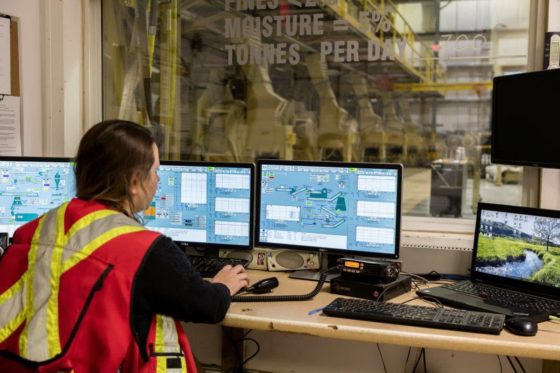Employers at wood pellet mills need to ensure their operators can easily detect, understand, and respond to alarms for preventing fires and explosions.

Photo credit: © Pinnacle Renewable Energy, used
with permission
Operators at wood pellet mills who oversee the manufacturing processes get a lot of “screen time.”
This is certainly true for operators working for Pinnacle Renewable Energy, Canada’s largest wood pellet manufacturer, with eight operations in B.C. and Alberta.
Steve Mueller, Pinnacle’s director of health and safety, says there are usually three or four large-screen monitors directly in front of operators that show all the system information they are tracking. Above them are several video monitors with six to eight split-screen views of different areas of the plant and coloured lights that indicate what’s happening in various parts of the operation.
Within all this visual information are many different types of alarms. Most are routine alerts about the manufacturing processes. But on rare occasions, other alarms indicate there are sparks or other upset conditions that could lead to a fire or explosion.
Knowing the difference is crucial.
“It’s really important for operators to be able to prioritize alarms, and to understand that an alarm means a critical situation they must react to,” says Steve. “You can’t just dismiss the alarm and carry on business as usual.”
Prioritizing alarms to respond effectively
WorkSafeBC is encouraging employers to review the design of their monitoring and alarm systems to ensure operators can respond appropriately.
At Pinnacle, Steve and his team did a review of their human-machine interface (HMI) to help their operators. An HMI is the user interface in a manufacturing or process control system. Performing an HMI review can help employers improve the effectiveness of their monitoring and alarm systems.
Pinnacle’s HMI evaluation included a weekly review of alarms in their system to see which ones were triggered most frequently.
According to Improving pellet mill monitoring and alarm systems helps operators respond effectively from WorkSafeBC, other best practices that can help reduce risk at a mill include:
- Set the system to differentiate critical alarms from process-fault alarms
- Know what could go wrong and what to do about it
- Prepare for uncommon and potentially critical situations
- Design the HMI display so the important information stands out
Thanks to Steve for talking with me about this — and also for being a loyal reader of the Speaking of Safety blog.


